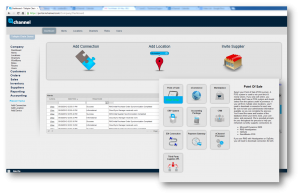(This post was originally published on October 18th, 2012. We’ve updated it for accuracy and completeness.)
Are you thinking about expanding your eCommerce business to new sales channels? It’s one of the best things you can do for your business. It sets your business up for wider distribution across a much larger audience.
However, running a multichannel eCommerce business does not come without its obstacles. One of the biggest challenges in eCommerce remains being able to rein in all channels to create free-flowing, accurate operational processes.
Think of it like this:
You start with your own website then branch out to marketplaces like eBay and Amazon in order to reach more potential customers. More often than not, your eCommerce solution isn’t going to be connected to these two sites, which means you will still need to manually update your systems.
Whenever an item is purchased on eBay or Amazon, you must then update your webstore, along with the inventory report to ensure that the product purchased on a separate site is synced with the information you have in other places.
While this method of manually updating your eCommerce systems can work, you always run the risk of human error. Without an automated process to ensure accuracy, you face potential backorders, pricing discrepancies, and other problems that leave customers dissatisfied.
The Challenge of Growth
When running an eCommerce business, you will certainly want it to grow, from increasing your site visits and customers to growing your revenue channels. But as you grow, you have more systems and more data to keep up with.
This remains a major challenge of multichannel eCommerce. As noted above, many systems are unable to connect all locations through which you sell your products. And as you grow, manually updating your online sales channels and inventory can be an almost impossible task.
So How Can You Avoid These Multichannel eCommerce Challenges?
Selling across multiple online sales channels is complex. It’s easiest to understand its challenges when broken down by data type. These 5 major data types each have their own challenges and solutions to overcome them.
Products
One of the toughest challenges for multichannel merchants is listing products across multiple channels. It’s tempting to use the same listings over and over. But, this doesn’t create a good experience. Each channel has its own audience and listing requirements. Your listings should be tailored those differences.
Solution: Merchants often use Product Information Management solutions to centrally manage all their product data. Robust software like PIM is capable of consolidating, cleaning, and exporting product data to all sales channels.
Inventory
Your items are listed across all your online channels. This means that customers can purchase the same inventory, whether from your webstore or marketplace account. If inventory levels aren’t update after every sale, you run the risk of overselling. If you oversell on Amazon, they can kick you off their marketplace for good.
Solution: Multichannel merchants need real-time inventory updates. This ensures that inventory levels are always accurate across every sales channel. This is imminent for holiday selling or flash sales where inventory can sell quickly.
Orders
Most businesses use a separate back-end system like an ERP to track and manage their orders. When systems aren’t connected, employees must hand-key eCommerce order data into other systems. This can take hours and cause 24+ hour delays for other teams.
Solution: Use a system that automates order processing. You shouldn’t rely on manually entering information across different systems. This takes too much time and is prone to errors. In some cases, your complex needs could warrant a system that can handle distributed order management capabilities.
Customers
Today’s customers shop with those who provide the best customer experience. Customers don’t see channels. They just see where they are able to purchase. As customers research and buy both online and offline, their entire shopping history needs to be accessible, which can be difficult to provide.
Solution: Customer data should be managed in a central location. It doesn’t matter where a customer purchased, reviewed, or returned a product. They should be able to shop when and wherever they need. This helps build your customer loyalty.
Shipping/Tracking
Customers expect affordable (read free), fast, and accurate online delivery. Amazon has set the bar high for shipping times and reliability. It’s hard for merchants to keep up to that standard.
Solution: When you rely on hand-keying fulfillment information, you’re prone to human error. This can lead to deliveries that take too long or never arrive. Most merchants turn to 3PLs to pick and pack their shipments or optimize their supply chain on their own to keep up with the likes of Amazon.
The Importance of Overcoming Challenges in eCommerce
There is certainly an obvious importance to overcoming the challenges your eCommerce business faces. Not only do you need a solution to help your business grow, but it is equally important to be aware of your customers and their attitude towards your business and its products.
In today’s age, with social media and blogs becoming such prevalent sources for information and reviews, you must be conscious of a customer’s experience in your web store or anywhere else you sell products.
The right kind of multichannel eCommerce solution goes a long way in making a customer’s experience on your site an enjoyable one. With your eCommerce sites and inventory synced, you have more time to respond to your customers; needs, which can very well end up being the best way in which to grow your business.







Join The Conversation